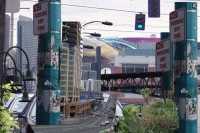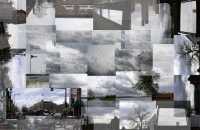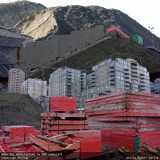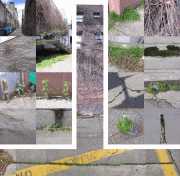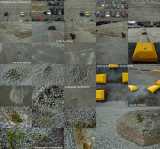What does “landscape” mean in the city center? How can a “built environment” be described? According to my laptop thesaurus, “landscape” is synonymous with “scenery, countryside, land, site, scene, setting, background, backdrop, backcloth, panorama, view, topography, geography, terrain, environment, surroundings.” “Environment” equates with “surroundings,” “background,” and the “natural world.”
Such terms bring to mind images of earth, ocean, foliage, and sky. However in the urban context, the natural environment is obscured or modified by human interventions. Squint your eyes as you take in the views from the city sidewalk. Towers, spires, and utility poles punctuate the sky in place of trees. Foliage is the exception instead of the rule. Canyons are shaped by skyscrapers, and through them flow sidewalks and streets, not rivers. Even the panorama of Seattle’s distant mountains is challenged by human creations as buildings of all varieties compete for space and attention on the horizon.
What shapes our experience of sky?
In high school I had the good fortune to travel to Italy. An old family friend sat me down before I left, giddy with romantic memories of her own travels, and told me to do one thing while there: look up. She claimed that the Italian sky was unlike one she had experienced anywhere else in her life.
The sky is an integral part of the exterior landscape, yet our experience of it is drastically shaped by our environment. In an open field it appears as an awesome expanse, while in a dense urban environment it takes shape around building profiles. We view it through windows, shield ourselves from it with curtains, see it through tree boughs and skylights. Our perception of it changes with the context of the world that we inhabit.
For this project I went on a quest to experience the sky through several different landscapes. I took photos in an interior setting looking out (my apartment), in a fairly dense urban environment (the U-District), in a less dense urban environment (UW campus), and in a non-urban environment (Magnuson Park). Special attention was put on the border between earth and sky.
Documenting the process of sky through photographs a difficult one because one experiences the vastness of sky through peripheral vision rather than looking directly up at it. It is, of course, possible to look at the sky in this manner, but looking at the sky is very different than experiencing it. For this reason I chose to focus the montage on the border between sky and earth, while fading these photos into an ambiguous skyscape. I was fortunate to be doing a project of this subject at this time of year, because spring in Seattle always brings on the most dramatic of skies.“To characterize landscape as dynamic and architecture as static based on their qualities is… ultimately reductive.” – Ashley Schafer and Amanda Reeser
An initial impulse in distinguishing landscape and architecture is perhaps to see landscape as something inherently more flexible and adaptable to change than architecture, that “landscape” implies natural processes that occur without the help of man, whereas buildings are only constructed by man. But as Schafer and Reeser note, this is misleading. Some landscapes are entirely fabricated structures, erected by man in much the same way that a building might be. The Olympic Sculpture Park in Seattle is an example of what will be a “natural” landscape that is entirely constructed. The association of landscape with topography is strong, and irregular topography can often suggest a natural landform. But buildings also create a certain kind of irregular topography, although we never call it that. We experience this sort of topography only from deep within it (between buildings) or from a distance (viewing a skyline). The urban architectural topography changes constantly as new buildings are erected, old ones are torn down or altered. This photo montage is an attempt to show this common characteristic of topography between landscape and building, as well as to juxtapose images that challenge the ideas of landscape=natural, dynamic / architecture=man-made, static: a temporary “landscape” (the Sculpture Park under construction), a changing architectural topography (Belltown), and a man-made gravel hill (at a Fremont asphalt plant) significant and permanent enough to read as a hill in GIS topographical maps.
The urban alley possesses a landscape of its own. This is a very human space, where the services that support our industries occur: garbage collection, loading and unloading, smoke breaks, the private side of public buildings. As a vehicle acessway first and foremost, it is paved with a hard membrane, its every surface impervious, suggesting a solidity and permanence. Yet through the concrete plants begin to grow, pushing through cracks, climbing up walls, sprouting out of pipes and clinging to areas of moisture. In defiance of our conventional understanding of a building acting on a landscape, the landscape is here acting on the surrounding buildings. The roles of figure and ground are reversed, giving more power to the forces of nature over the efforts of man. The reclamation of green life within a built landscape reinforces the transience of those buildings, and implies their eventual return to the earth.
This project also explores the tension between the horizontal and vertical elements of the landscape. The traditional idea of landscape is defined by the horizon line. Yet the growth of plants is generally vertical, and the line of a vine growing up a wall provides a counterpoint to the horizontal landscape. A horizontal landscape can become a passive recipient of the human gaze, but a vertical landscape possesses an active role of growth and renewal.The parking lot in the city is one of the easiest to recognize and the most basic units of space within the city. These landscapes are placeholders for the built world, a first attempt of dominance of man over nature. This lot, like most others, is a clearing of the organic and natural elements of the land, covered by a monochromatic palette of inorganic, man-shaped material—in this case rock. Here, the rock takes the form of solid masses with the concrete barriers, and of a liquid, with the fluid gravel that forms the sea-like base of the landscape.
The concrete barriers are the design. They are deliberately shaped and cast by man, then placed in a rational pattern across the sea of gravel. They influence the flow of traffic, which ultimately gives shape to the un-designed landscape.
The surface of the landscape is constantly reshaped as the activities taking place upon the sea of gravel are imprinted as track and tire marks from automobiles, and occasional a footprint. The history of the traffic is all visible, yet one can only guess which is the oldest marking. The overlapping markings have over time developed a three-dimensional texture, which is rapidly changing at the small scale, yet more slowly being effected at the scale of the whole landscape. What was intended as a banal landscape of the void instead reveals its vitality.
Along with the resulting spaces of activity exists spaces of inactivity, or seldom-activity. It is here that one finds the temporary nature of man’s dominance over nature. It becomes apparent that landscape of man must continuously be maintained to suppress nature.
